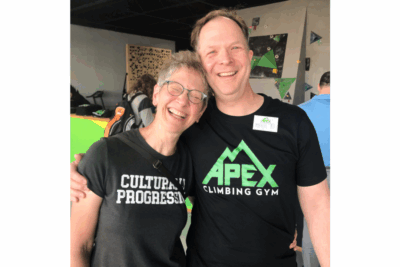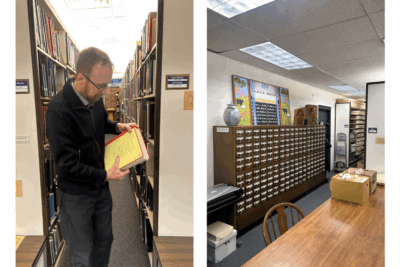One facet of college life that has become almost synonymous with U.S. higher education is that of “Greek life,” or fraternities and sororities. Goshen College has never been a part of this student organizational system, however, while they weren’t frats, GC did use its literary societies.
These societies began in 1900 as a division of the, at the time too large, Ciceronian Debating club. The resulting societies were called the Aurora Society and the Coming Men of America Debating Club, which later changed its name to the Adelphian Society. These were the societies for men on campus. As for women, around the same time as the Ciceronean split, the Philomathean Society was divided to create the Avon and Vesperian Societies. All four of these groups would last for more than 60 years on campus. As described in the “Solicitation Handbook for Goshen College Men” of 1956, “From the beginning there was spirited rivalry between the societies … keen competition contributes to a continuing development in the quality of their programs.”As for who joined which group, the decision was left up to individual students, but some societies, like the Adelphians, used slogans such as “Iowa (or Canada or Hesston) goes Adelphians.” Additionally, the Avons and Auroras were brother-sister clubs, as were the Adelphians and Vesperians.
The societies were also responsible for contributing to the shaping of GC’s campus, as it was the Adelphians who erected the Adelphian fountain, the Auroras who placed the cornerstone at the entrance to the AD building, the Avons who provided Assembly Hall (the original auditorium, built on the second floor of the AD building) with light fixtures and the Vesperians who equipped the “Vesperian Laboratory of Physics and Astronomy” and purchased a 3 and a half inch telescope for it.
One main responsibility of the societies was also to host the spring festival each year, which typically included a dinner, a full length play, musical performances and singing. These lasted annually from at least 1947 to 1966. The societies also looked beyond arts to athletics. In his memories of GC, Dan Bodiker ‘64 said “one thing I can remember was there was always a basketball game every year between the rivals.”
Beyond just the literary societies however, GC has seen many clubs come and go over the years. Some of the most notable that seem a bit far fetched today are groups like the Aero club, which existed in the ‘50s and ‘60s, in which students paid roughly $390 to participate in everything necessary to receive their private pilot’s license, about half of what it would cost outside of college.
Also, for many years, the college hosted an Audubon Society, whose goal was to increase students’ love of nature, and to connect with the natural environment, as well as to, of course provide a space for birding.
In the ‘40s and ‘50s GC was home to the Camera Clique, a group that gathered students with a love of photography, and helped teach them how to develop their own photos. The Home Ec club was also a popular pick for GC students, in the 1971-72 school year hosting programs such as “Teaching Home Economics to Boys” and “The Changing Role and Structure of the Family.”
One group that may sound particularly odd to the modern ear was the Student Wives Fellowship, who were frequently seen on campus despite not being students. In an initial communication sent out in 1953, Virginia Oyer opened her letter by saying “All of us know at least some of the husbands attending college this year … The occasion at which we can find out who Mrs. ____’s husband is, and who Paul (someone … We can’t recall his full name) married is the semi-annual Family night Potluck supper.” Oyer also opened all of her letters with “Dear Student Wife.”
GC even had a Glee club way back in 1915, whose work was described in the yearbook as “successful in every sense of the word.” Members of the club said “The pleasant associations formed will never be forgotten and the experiences tingled by good cheer and good humor will be a source of satisfaction in the future.”
Other groups on campus no longer exist, but their work is being carried out in other forms. The Student Coalition for Undoing Racism began in 1993, and was supported at that time by groups such as LSU, BSU, ISC, Campus Ministries and the Student Senate. Others, such as the Goshen Student Women’s Association, went extinct more recently: they started in the ‘80s and their last event was held in 2020. Now, PIN has taken over Chocolate House, which used to be their marquee event, and Goshen Monologues has evolved with its own committee beyond the Vagina Monologues that they once sponsored.
Beyond even these examples, each decade at GC has seen the rise and fall of countless clubs and organizations. The second floor of the library is the perfect place to witness these highs and lows, as it houses the collection of almost 100 years worth of yearbooks, a monument to all of the students and their endeavors that have come before.




